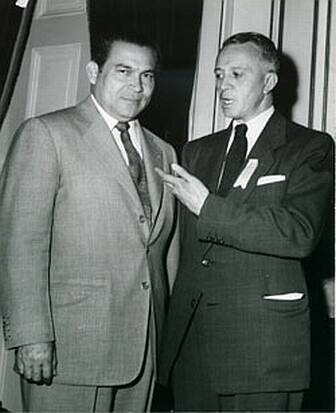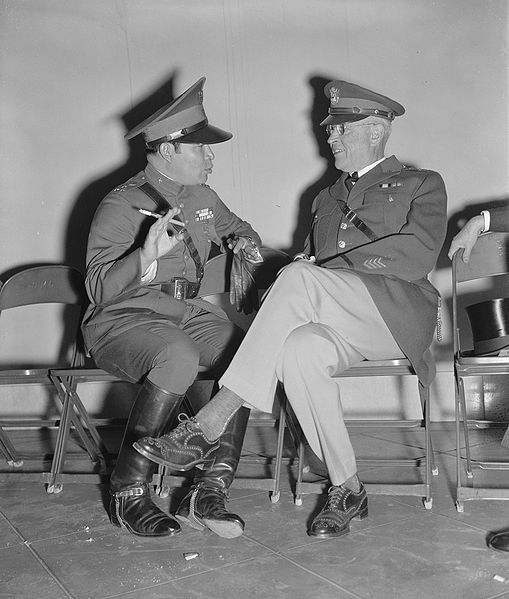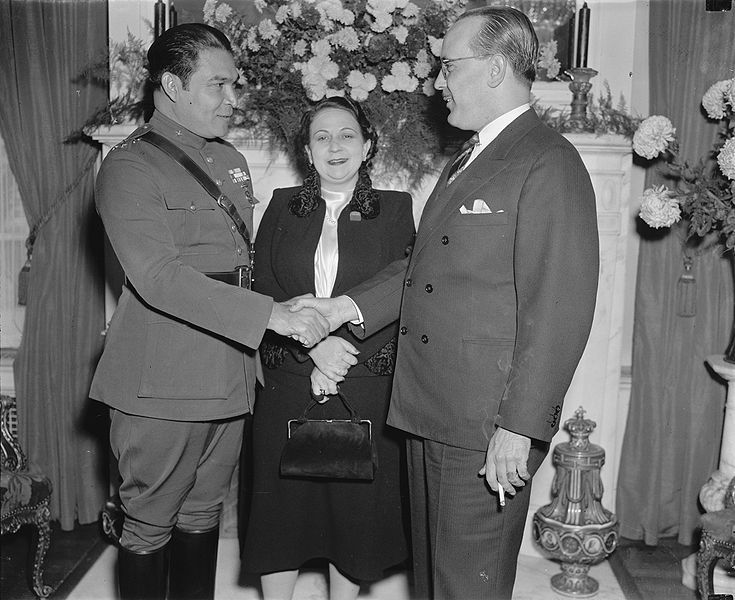<Back to Index>
- Philosopher Franz Clemens Honoratus Hermann Brentano, 1838
- Composer Niccolò Piccinni, 1728
- Dictator of Cuba Fulgencio Batista y Zaldívar, 1901
PAGE SPONSOR
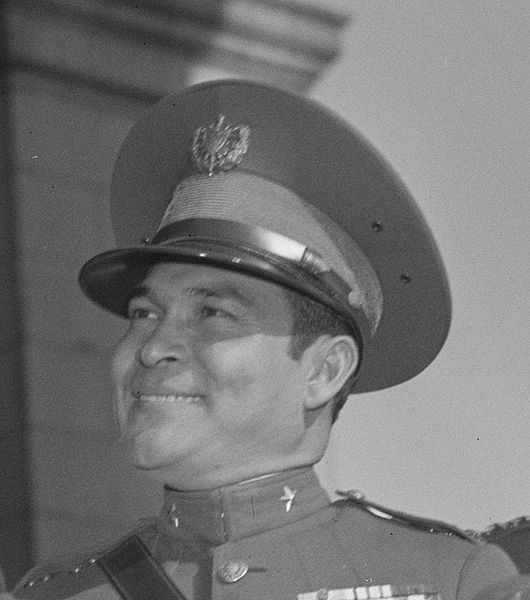
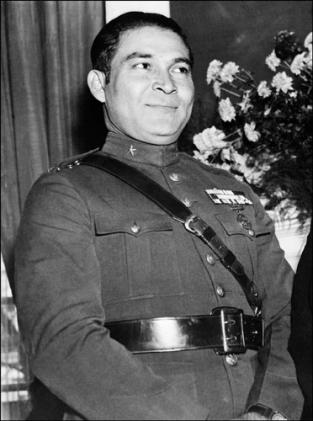
Fulgencio Batista y Zaldívar (January 16, 1901 – August 6, 1973) was a Cuban President, dictator, and military leader closely aligned with and supported by the United States. He served as the leader of Cuba from 1933 – 1944, and 1952 – 1959, before being overthrown as a result of the Cuban Revolution.
Batista initially rose to power as part of the 1933 "Revolt of the Sergeants" that overthrew the government of Gerardo Machado,
becoming the Army Chief of Staff, with the rank of colonel, and
effectively controlling the five-member Presidency. He maintained this control until 1940, when he was himself elected President of Cuba,
serving until 1944. From 1944 - 1952 he lived in the United States,
returning to Cuba as leader of a U.S. backed coup that preempted the
1952 elections in which Batista was running a distant third. Throughout
the 1950s, Batista's corrupt and repressive regime systematically
profited from the exploitation of Cuba's commercial interests, in
partnership with U.S. corporations and the American Mafia. As a result, for three years Fidel Castro's July 26th Movement and other rebelling elements led a guerrilla uprising against Batista's regime which culminated in his eventual defeat following the Battle of Santa Clara on New Year's Day 1959. Batista immediately fled the island with an amassed personal fortune. Batista eventually found political asylum in Portugal, where he lived until dying of a heart attack on August 6, 1973 near Marbella, Spain. Batista was born in Banes, Cuba in 1901, to Belisario Batista Palermo and Carmela Zaldívar González, who had fought for independence from Spain.
His mother named him Rubén and gave him her last name,
Zaldívar. His father did not want to register him as a Batista.
In the registration records of the Banes courthouse he was legally
Rubén Zaldívar until 1939, when, as Fulgencio Batista, he
became a presidential candidate and it was discovered that this name
did not exist. It is alleged that a judge was bribed 15,000 Cuban pesos
(about the same amount in U.S. dollars at the time) to fix the
discrepancy. Of mixed European, African, Chinese and Amerindian descent, Batista was considered a mulatto socially. He was educated in an American Quaker school. Coming from a humble background, he earned a living as a laborer in the cane fields, docks and railroads. He was a tailor, mechanic, charcoal vendor, fruit peddler, and an Army stenographer. In 1921, he traveled to Havana and joined the army. After promotion to Sergeant, he became the union leader of Cuba's soldiers. In 1933, Batista led an uprising known as the "Revolt of the Sergeants," as part of the coup which overthrew the government of Gerardo Machado. Machado was succeeded by Carlos Manuel de Céspedes y Quesada,
who lacked a political coalition that could sustain him and was
replaced a short time thereafter. A short-lived five-member presidency,
known as the Pentarchy of 1933,
was established, including a representative from each anti-Machado
faction; Batista was not a member but was in control of Cuba's armed
forces. Within days the representative for the students and professors
of the University of Havana, Ramón Grau San Martín,
was made president and Batista became the Army Chief of Staff, with the
rank of colonel, and effectively controlled the presidency. The majority of the commissioned officer corps were forcefully retired or, as some speculate, killed. Grau himself remained president for just over 100 days before Batista, conspiring with the U.S. envoy Sumner Welles, forced him to resign in January 1934. Grau was replaced by Carlos Mendieta,
and within five days the U.S. recognized Cuba's new government, which
lasted eleven months. Batista then became the strongman behind a
succession of "puppet presidents" until he was himself elected
president in 1940. After Mendieta, succeeding governments were led by José Barnet (5 months) and Miguel Mariano Gómez (7 months) before Federico Laredo Brú ruled from December 1936 to October 1940. Batista, supported by a coalition of political parties, defeated Grau in the first presidential election under the new Cuban constitution in the 1940 election, and served a four year term as President of Cuba. Although Batista was a capitalist and an admirer of the United States, he was endorsed by the old Communist Party of Cuba, which at the time had little significance and no chance of an electoral victory. This support was primarily due to Batista's labor laws and his support for labor unions with which the communists had close ties. In fact, Communists attacked the anti-Batista opposition, saying Grau and others were "fascists", "reactionaries" and "Trotskyists." During this term in office, Batista carried out major social reforms and established numerous economic regulations and pro-union policies. Cuba entered World War II on the side of the Allies on December 8, 1941, declaring war on Japan the day following the attack on Pearl Harbor.
On December 11, the Batista government declared war on Germany and
Italy. In December 1942, after a friendly visit to Washington, Batista
said Latin America would applaud a decision by the United Nations to go to war with Francisco Franco's Spain. In 1944, Batista's handpicked candidate for President, Carlos Saladrigas Zayas, was
defeated by Grau. In the final months of his presidency, Batista sought
to handicap the incoming Grau administration. In a July 17, 1944
dispatch to the U.S. Secretary of State, U.S. Ambassador Spruille Braden stated: Shortly
after the inauguration of his successor Batista left Cuba for the
United States. "I just felt safer there," he said. He divorced his
wife, Elisa, and married Marta Fernández Batista in 1945; two of
their four children were born in the United States. For the next eight
years Batista remained in the background, spending time between the Waldorf-Astoria in New York City and in a home in Daytona Beach, Florida. He continued to participate in Cuban politics and was elected to the Cuban Senate in absentia in
1948. Returning to Cuba, he decided to run for president and was given
permission by President Grau, whereupon he formed the Unitary Action
Party. In 1952, Batista again ran for president. In a three-way race, Roberto Agramonte of the Ortodoxos party led in all the polls, followed by Dr. Carlos Hevia of the Auténtico party, while Batista was running a distant third. On
March 10, 1952, three months before the elections, Batista, with army
backing, staged a coup and seized power. He ousted outgoing President Carlos Prío Socarrás,
canceled the elections and assumed control of the government as
"provisional president". Shortly after the coup, the United States
government recognized his regime. Upon his return to power, Batista did not continue the progressive social
policies of his earlier term. He was consumed with overcoming his
social status and being accepted by Cuba's upper class, who had never
allowed him membership in their social circles and clubs. He also
concentrated heavily on increasing his own personal fortune. Meanwhile,
poverty on the island was growing. In 1953, the average Cuban family
had an income of $6.00 a week, 15 to 20 percent of the labor force was
chronically unemployed, and only a third of the homes had running water. The Dallas industrialiat Jack Crichton joined with several other oilmen to negotiate drilling rights in Cuba under the Batista administration. Standard Oil of Indiana signed an agreement with the Cuban-Venezuelan Oil Voting Trust Company, a unit originally established by William F. Buckley, Sr., for access to fifteen million acres. CVOVTC was during the middle 1950s one of the four or five most traded entities on the American Stock Exchange.
Batista's successor, Fidel Castro, reduced the size of claims for oil
exploration to a maximum of twenty thousand acres and ended large-scale
explorations by private companies. Batista established lasting relationships with organized crime, notably with American mobsters Meyer Lansky and Lucky Luciano, and under his rule Havana became known as "the Latin Las Vegas." Batista
and Lansky formed a renowned friendship and business relationship that
lasted for three decades. During a stay at the Waldorf-Astoria in New
York in the late 1940s, it was mutually agreed upon that, in exchange
for kickbacks, Batista would offer Lansky and the Mafia control of
Havana’s racetracks and casinos. After World War II, American mobster Lucky Luciano was paroled from prison on the condition that he permanently return to Sicily.
However, Luciano secretly moved to Cuba, where he worked to resume
control over American mafia operations. Luciano also ran a number of
casinos in Cuba with the sanction of Batista, though the American
government eventually succeeded in pressuring the Batista regime to
deport Luciano. Batista
encouraged large-scale gambling in Havana, announcing by 1955, that
Cuba would grant a gaming license to anyone who invested U.S. $1
million in a hotel or $200,000 in a new nightclub - and that the Cuban
government would provide matching public funds for construction, a
10-year tax exemption, and duty-free importation of equipment and
furnishings. The government would get U.S. $250,000 for the license
plus a percentage of the profits from each casino. The policy waived
the background checks that were required for casino operations in the
United States, and opened the door for casino investors with illegally
obtained sources of funding. Since import duties were waived on
materials for hotel construction, Cuban contractors with the right
connections made windfalls by importing more than was needed and
selling the surplus to others for hefty profits. It was rumored that
besides the U.S. $250,000 to get a license, a fee sometimes more was
required under the table. Lansky became a prominent figure in Cuba's gambling operations, and exerted influence over Batista's casino policies. Lansky associate Chauncey Holt described Batista as "always in Lansky's pocket." Lansky
also turned Cuba into an international drug trafficking port, while
Batista was said to have received up to 30 percent of Lansky’s profits
from casinos and hotels built there. The Mafia's Havana Conference was held on December 22, 1946 at the Hotel Nacional. This was the first full-scale meeting of American underworld leaders since the Chicago meeting in 1932. Lansky
set about reforming the Montmartre Club which soon became the in place
in Havana. He also long expressed an interest in putting a casino in
the elegant Hotel Nacional, which overlooked El Morro,
the ancient fortress guarding Havana harbor. Lansky planned to take a
wing of the 10-story hotel and create luxury suites for high stakes
players. Batista endorsed Lansky’s idea over the objections of American expatriates like Ernest Hemingway and the elegant hotel opened for business in 1955 with a show by Eartha Kitt. The casino was an immediate success. Once
all the new hotels, nightclubs and casinos had been built Batista
wasted no time collecting his share of the profits. Nightly, the
"bagman" for his wife collected 10 percent of the profits at
Trafficante's interests; the Sans Souci cabaret, and the casinos in the
hotels Sevilla-Biltmore, Commodoro, Deauville and Capri (part-owned by
the actor George Raft). His take from the Lansky casinos, his prized Habana Riviera, the Nacional,
the Montmartre Club and others, was said to be 30 percent. What exactly
Batista and his cronies actually received in total in the way of
bribes, payoffs and profiteering has never been certified. The slot
machines alone contributed approximately U.S. $1 million to the
regime's bank account. In
a manner that antagonized the Cuban people, the U.S. government used
their influence to advance the interests of and increase the profits of
the private American companies, which "dominated the island's economy." As a symbol of this relationship, ITT Corporation, an American-owned multinational telephone company, presented Batista
with a gold-plated telephone, as an "expression of gratitude" for the
"excessive telephone rate increase" which Batista had granted at the
urging of the U.S. government. Earl T. Smith,
former U.S. Ambassador to Cuba, testified to the U.S. Senate in 1960
that "until Castro, the U.S. was so overwhelmingly influential in Cuba
that the American ambassador was the second most important man,
sometimes even more important than the Cuban president." In
addition, nearly "all aid" from the U.S. to Batista's regime was in the
"form of weapons assistance", which "merely strengthened the Batista
dictatorship" and "completely failed to advance the economic welfare of
the Cuban people". Such
actions later "enabled Castro and the Communists to encourage the
growing belief that America was indifferent to Cuban aspirations for a
decent life." Senator John F. Kennedy,
in the midst of his campaign for the U.S. Presidency, described
Batista's relationship with the U.S. government and criticized the
Eisenhower Administration for supporting him, on October 6, 1960: Just over a year after Batista's second coup, a small group of revolutionaries attacked the Moncada Barracks in Santiago on
July 26, 1953. The assault was easily defeated and many of its leaders
executed, while others were jailed. Among those jailed was the primary leader of the attack, Fidel Castro,
a young attorney who had been running for parliament in the canceled
1952 elections. In the wake of the Moncada assault, Batista suspended
constitutional guarantees and increasingly relied on police tactics in
an attempt to "frighten the population through open displays of
brutality." Batista
held an election in 1954, which the opposition boycotted. Just before
the election his opponent, Grau, withdrew from the campaign, charging
that his supporters had been terrorized. Thus, Batista was elected
president with 45.1% of the votes. Grau received only 6.8%. By
late 1955, student riots and anti-Batista demonstrations had become
frequent. These were dealt with in the violent manner his military
police had come to represent. All youth were seen as suspects, and
merely to be a "University student, was enough in many cases to warrant
a sentence of death." Due to its continued opposition to Batista, the University of Havana was
temporarily closed on November 30, 1956. (It would not reopen until
early 1959, after a revolutionary victory.) Student leader Jose Antonio
Echeverría was killed by police outside a radio station he had
taken over to make broadcasts, in concert with an attack on the
Presidential Palace on March 13, 1957. In April 1956, Batista called popular military leader, Col. Ramón Barquín back to Cuba from his post as military attaché to the United States. Believing Barquín would support his rule, Batista appointed him General and Chief of the Army. However, Barquín's Conspiración de los Puros (Conspiracy
of the Pure) was already underway and had already progressed too far.
On April 6, 1956, Barquín led a coup by hundreds of career
officers but was frustrated by Lieutenant Ríos Morejón,
who betrayed the plan. Barquín was sentenced to solitary
confinement for eight years on the Isle of Pines, while many officers were sentenced to death. The purge of the officer corps contributed to the inability of the Cuban army to successfully combat Castro and his guerrillas. Batista's police responded to increasing popular unrest by torturing and killing
young men in the cities; his army, however, was ineffective against the
rebels based in the Sierra Maestra and Escambray mountains. Another possible explanation for the failure to crush the rebellion was offered by author Carlos Alberto Montaner:
"Batista does not finish Fidel out of greed ... His is a government of
thieves. To have this small guerrilla band in the mountains is to his
advantage, so that he can order special defense expenditures that they
can steal." Batista's rule became increasingly unpopular among the population, and the Soviet Union began to secretly support Castro. In
an effort to gather information about Castro's army, people were pulled
in by Batista's secret police for questioning. Many innocent people
were tortured by Batista's police, while suspects, including children,
were publicly executed as a warning to others who were considering
joining the insurgency. Additionally,
"Hundreds of mangled bodies were left hanging from lamp posts or dumped
in the streets in a grotesque variation of the Spanish colonial
practice of public executions." The
behavior of Batista's forces backfired and increased support for the
guerrillas. In 1958, forty-five organizations signed an open letter
supporting the 26th of July movement,
among them national bodies representing lawyers, architects, dentists,
accountants and social workers. Castro, who had originally relied on
the support of the poor, was now gaining the backing of the influential
middle classes. The United States supplied Batista with planes, ships, tanks, and the latest technology such as napalm which were used in his battle against the insurgency. However, in March 1958, the U. S. announced it would stop selling arms to the Cuban government. Soon after, the U.S. imposed an arms embargo and recalled their ambassador, further weakening the government's position, although land owners and others who benefited from the regime continued to support Batista. In
March 1958, President Eisenhower, disillusioned with Batista's
performance, suggested he hold elections. Batista did, but the people
showed their dissatisfaction with his government by refusing to vote.
Over 75% percent of the voters in the capital, Havana,
boycotted the polls. In some areas, such as Santiago, it was as high as
98 percent. The election placed another Batista puppet, Andrés Rivero, in the president's chair, but Batista knew losing the support of the U.S. government meant his days in power were numbered. On December 11, 1958, U.S. Ambassador Earl Smith visited
Batista at his hacienda, "Kuquines". There Smith informed him that the
United States could no longer support his regime. Batista asked if he
could go to his house in Daytona Beach. The ambassador denied his
request and suggested instead that he seek asylum in Spain. On December 31, 1958, Batista raised a New Year's Eve toast to his cabinet members and senior military officers and told them hasta la vista.
After seven years, Batista knew his presidency was over and fled the
island in the early morning hours as rebel forces entered Havana. At
three A.M. on January 1, 1959, Batista boarded a plane at Camp Columbia
with one hundred and eighty of his supporters and flew to Ciudad Trujillo in the Dominican Republic. With him went his personal fortune of more than US$300 million amassed through graft and payoffs. Critics
accused Batista and his supporters of taking as much as
US$700 million in fine art and cash with them as they fled into
exile. As news of the fall of Batista's government spread through Havana, The New York Times described
the scene as one of jubilant crowds pouring into the streets and
automobile horns honking. The black and red flag of the 26th of July
Movement waved on automobiles and buildings. The atmosphere was
chaotic. On January 8, 1959, Castro and his army rolled victoriously
into Havana. Batista
was not welcome in the Dominican Republic. Having already been denied
entry to the United States, he sought asylum in Mexico, which also
refused him entry. Portugal's dictator António Salazar allowed him to settle there on condition he completely remove himself from politics. By
the end of Batista's rule, described by U.S. President John F. Kennedy
as "one of the most bloody and repressive dictatorships in the long
history of Latin American repression", 20,000 Cubans had been killed. Batista later moved to Madeira, then Estoril, outside Lisbon, Portugal,
where he lived and wrote books the rest of his life. He was also the
Chairman of a Spanish life insurance company which invested in property
and mortgages on the Spanish Riviera. He died of a heart attack on August 6, 1973 at Guadalmina, near Marbella, Spain, two days before a team of assassins from Castro's Cuba could carry out a plan to kill him. Marta Fernandez Miranda de Batista, Batista's widow, died on October 2, 2006. Roberto Batista, her son, says that she died at her West Palm Beach home. She had suffered from Alzheimer's disease and had a heart attack on September 8, 2006. Batista was buried with her husband in San Isidro Cemetery in Madrid after a mass in West Palm Beach.
“ The
corruption of the Government, the brutality of the police, the regime's
indifference to the needs of the people for education, medical care,
housing, for social justice and economic justice ... is an open
invitation to revolution. ”
“ Brothels flourished.
A major industry grew up around them: Government officials received
bribes, policemen collected protection money. Prostitutes could be seen
standing in doorways, strolling the streets, or leaning from windows.
One report estimated that 11,500 of them worked their trade in Havana.
Beyond the outskirts of the capital, beyond the slot machines, was one
of the poorest, and most beautiful countries in the Western world. ”
“ I
believe that there is no country in the world including any and all the
countries under colonial domination, where economic colonization,
humiliation and exploitation were worse than in Cuba, in part owing to
my country’s policies during the Batista regime. I approved the
proclamation which Fidel Castro made in the Sierra Maestra, when he
justifiably called for justice and especially yearned to rid Cuba of
corruption. I will even go further: to some extent it is as though
Batista was the incarnation of a number of sins on the part of the
United States. Now we shall have to pay for those sins. In the matter
of the Batista regime, I am in agreement with the first Cuban
revolutionaries. That is perfectly clear. ”
